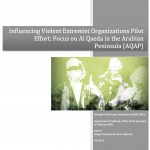Influencing Violent Extremists: Focus on Al Qaeda in the Arabian Peninsula (AQAP)

Influencing Violent Extremists: Focus on Al Qaeda in the Arabian Peninsula (AQAP)
Author | Editor: Desjardins, A. & Adelman, J. (NSI, Inc).
In 2010 the Strategic Multi-Layer Assessment (SMA) office saw a need to bring academics, practitioners, and individuals from all branches of the United States government together to discuss the current research and debate issues surrounding extremist violence: Defining a Strategic Campaign for Working with Partners to Counter and Delegitimize Violent Extremism (CVE) and the Neurobiology of Political Violence. The findings from the two conferences clearly indicated that a detailed examination of a violent extremist organization from a multi- method approach was required in order to begin down the path of understanding.
The CVE workshop was held from 19-20 May 2010 at Gallup World Headquarters in Washington, DC. The workshop focused on strategic communications and violent extremism and was designed to inform decision makers and was not intended as a forum for policy discussion. The workshop emerged from an SMA- and AFRL- sponsored white paper entitled Protecting the Homeland from International and Domestic Terrorism Threats: Current Multi-Disciplinary Perspectives on Root Causes, the Role of Ideology, and Programs for Counter-radicalization and Disengagement. The key insights and findings of the CVE workshop are as follows:
- Violent extremism cannot be reduced to one singular or simple cause
- The difficulties of pursuing deradicalization and delegitimization are numerous. The question to ask is if this is an appropriate or attainable goal
- Multi-perspective, tailored approaches are key to effective counter-terror strategic communications
- The ways the US uses vocabulary and themes is critical to success of its strategic communications
The Neurobiology of Political Violence: New Tools, New Techniques workshop hosted by the National Institutes of Health (NIH), United States Strategic Command (STRATCOM), the Joint Staff, and the Strategic Multilayer Assessment Office (OSD) in Bethesda, MD from 1-2 December 2010. The workshop facilitated a broad discussion of the current state of the art within the related fields of neuroscience, neurobiology, and social psychology as it relates to deterring political violence. While most panelists emphasized the prematurity of applying current research to real world problems within the national security and homeland defense space, they all agreed that the tools of neuroscience and related fields would serve to better inform current deterrence and messaging strategies. The key insights and findings from the workshop are below:
- Neuroimaging (e.g., MRI) has great utility and provides added insights devoid of self- report biases.
- In-group/out-group receptivity to reconciliation has a neurobiological basis and can be modified by rhetoric.
- New tools and techniques are emerging.
- Culture and environment influence behavior and brain function.
- It is critical to continue basic research in this area.
The Influencing Violent Extremist Organizations (IVEO) Pilot Effort was organized by the Strategic Multilayer Assessment (SMA) Office in the Department of Defense (DoD) and supported by the Joint Staff (J-3), Strategic Command (STRATCOM), and the Assistant Secretary of Defense for Research and Engineering. The Pilot Effort fits into the broader IVEO effort, which has the objective of first improving the United States Government’s (USG) understanding of potential unintended consequences of influence actions against VEOs and, second, suggesting principles for planning influence actions that mitigate potential negative effects and exploit potential opportunities to produce intended effects.4 The Countering Violent Extremist Organizations (VEOs) Pilot Effort: Focus on Al-Qaeda in the Arabian Peninsula (AQAP) effort was a multi-method, multi-disciplinary exploration of the selected VEO. AQAP was selected as the focus of the pilot effort due to its continued threat to the United States.
Social science has provided an extant literature surrounding the who, what, and why of violent extremist organizations. The who and the what are the easy parts. It’s really the why at a fundamental human level that—even after decades of research, including theorizing, empirically testing, and cautiously observing—still has social scientists in disagreement and searching for answers. This pilot effort provided a unique approach to investigate not only the why, but also the how, in violent extremist organization recruitment. Where does support come from, particularly global support that goes above and beyond a local connection? Assembling the top researchers in this field to discuss more theories has been done before, and frankly, is not enough to move us to the next level of understanding and providing counterstrategies. In this pilot effort, we brought the best and brightest in to answer one question: given your area of expertise, what can we possibly do to counter recruitment in violent extremist organizations? From there, we aimed to synthesize these efforts into one coherent package that may take us beyond simple theoretical strategizing. Across the fields of social psychology, social neuroscience, evolutionary psychology, political psychology, and communication science, this work is truly an interdisciplinary effort.
This quick turnaround effort began in early March and culminated in early August, with the final report delivered late-September of 2011. Initially, each participant worked independently on their research. In late-July, all of the participants came together to begin integrating their findings across disciplines along with AQAP subject matter experts and practitioners to discuss the results and identify any gaps. The end result here is the final culmination of these efforts.
Selected Chapters:
- Social Identification, Influence, and Why People Join AQAP (A. Adelman & A. Chapman)

Comments